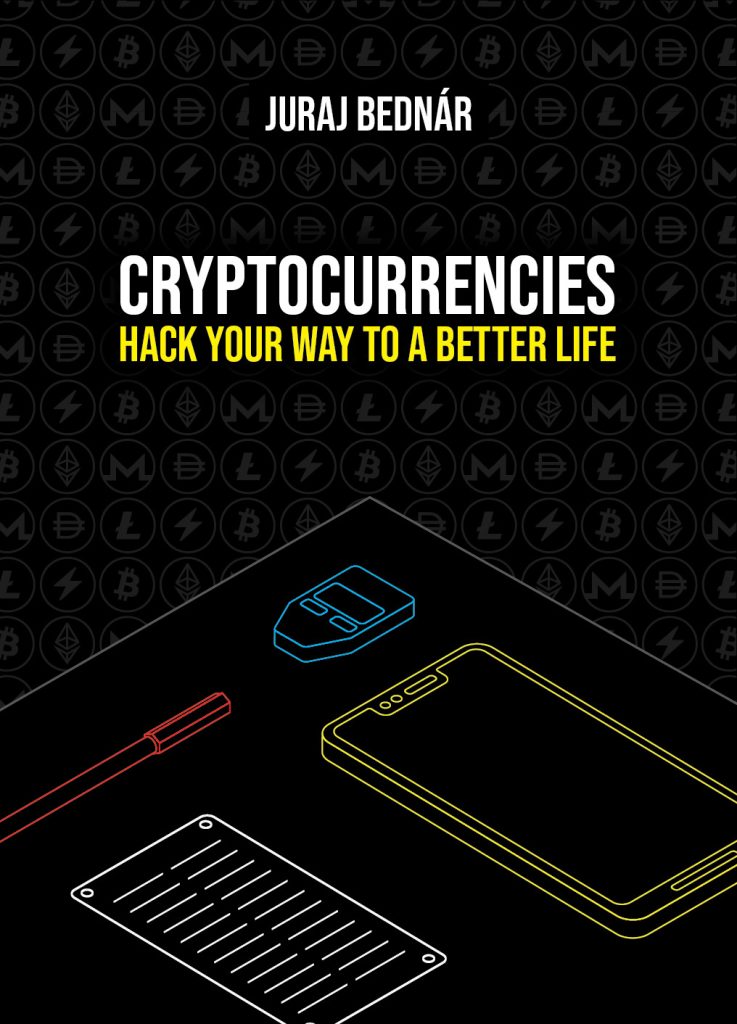As a teenager, I founded one of the first, if not the first Czechoslovak web e-zine (today it would be something like a blog). It was called Netáčik. Later I started writing a column about security for PC Revue magazine, then Linux and open-source (together with Peter Paluch and other people). Alongside all this, the Internet was being born, and I wondered if it was just a hobby, or if it was something you could do for a living. Of course, PC Revue paid me royalties for my articles, which allowed me to be a cafeteria king in high school – I could buy whatever I wanted in the cafeteria :). And even for writing Netáčik I was practically paid by an ISP called Isternet, which supported the creators, because they couldn’t sell Internet access if there was no content on the Internet (in Slovak).
Since then, I have been interested in the question of rewarding creators on the Internet. There are many models and new ones are being invented – ads have basically changed from “let’s hang an ugly banner for a month right at the top” to auction-based display ads based on user profiles and big data/artificial intelligence and really sophisticated targeting.
In my book Veľký reštart (so far only in Slovak) I write: “The Internet is still a communication tool, turned into drops of dopamine injections mixed with ads. We have come to believe that everything on the Internet must be free, so we don’t even feel nauseous when we open such a “free site” full of flashing ads. We walk down a virtual street full of freely placed advertising flyers smiling at us, selling us hair shampoo and a new car. Occasionally, a spam-collecting robot walks down the street and dumps these flashing flyers into the trash. The World Wide Web in the 1990s may have looked primitive compared to today’s “pixel-perfect” design sites, tweaked colours, user-friendly controls… but there wasn’t yet a supermarket chain ad attacking the baser instincts.
Bananas for a euro! Discounts up to 30% only until Sunday! The best washing machine on the market! Affordable accounting software! “
In my other book Hackni sa, you will find something about trying to turn this model around: “The philosophy of the Internet, or at least the web, is this – we will provide you with services for free, but in return you will watch ads and we will sell your attention to advertisers.
There are a number of problems with this approach, although it is of course a legitimate business model.
….
The rewarding of authors goes through intermediaries. This is what the Brave browser is trying to turn around, for example (although I stopped using Brave and started using Firefox, I also teach how to set it up to care for privacy).
Brave tokenizes our attention using the cryptocurrency BAT (Basic Attention Token). We can thus choose to directly reward content creators when browsing the web. And if we are content authors and authenticate ourselves, we can automatically earn this cryptocurrency from users who use Brave. If you want, you can turn on ads through Brave on sites that support BAT and you can reward authors this way, either with your attention or directly with tokens. It’s sort of like “unforced paywall” where you simply pay the content creators according to your browser settings. And Brave blocks other ads.”
Advertising – a nuisance, can it be avoided?
A friend told me about a Google experiment where you could turn off ads on the Internet – but not by blocking them through your browser, but by standing on the other side of the equation and paying for the ad space yourself.
I mean, like this: If you open a site that is funded through advertising, a quick auction of ad space occurs. If you pay a flat fee, the service operator will participate in the auction on your behalf – to show you a transparent 1×1 square – i.e. no advertising.
The advantage of this approach is that the creators of the site are funded as if you had seen the ad. However, you don’t see it and you pay the site creator for the ad space. The interesting thing about this approach is that the first micropayment system to support content creators may have been developed through ad auctions in this way. I don’t know if this Google experiment exists today and if it is available in the marketplace, but YouTube Premium does something similar. This is a premium product with a monthly flat rate where you don’t see any ads on YouTube – without any hacking – and you also have access to YouTube Music (also ad-free). Personally, I pay for this product because ads before videos spoil my quality of life – although I don’t see ads much because my browser blocks them anyway. Now, however, I still support content creators – and since I create content myself, I know the creators deserve it, it’s a lot of work!
How to reward creators directly?
Patrons
The art market has somehow had it figured out for centuries. Patrons supported promising young artists, invested in their work, and over time the patrons made money because they were able to create artworks thanks to these investors and patrons owned some of their art themselves. More recently, a large secondary market for art has in turn supported the primary market. It pays to collect the work of an artist that you assume will be worth more in the secondary market in the future. And if their art means something to me and I like it, if I don’t make money, at least I’m left with art I really like.
Patreon and other forms of subscription
However, the Internet has also brought about “democratization” and thus made various forms of investing in art accessible to the masses. Singer Amanda Palmer talks about getting fans to support her through Patreon, and she started making music for them based on that. Anyone can become a patron this way, starting at $1 a month. People can buy the feeling that they’re supporting an author very cheaply.
In this way, content creators of all kinds – from blogs to comic books, musicians, philosophers, podcasters to professional anarchists – can get support directly from the people for whom they create content. Patreon sounds like a new idea, but various investment or other paid newsletters are a fairly old thing, even from pre-internet times.
Art auctions, NFTs
However, art is also auctioned in auction houses, and now auctions also include digital art on the Internet. A new phenomenon called Non fungible tokens enables this in a cool new decentralized way. NFT is a form of cryptocurrency that represents a unique object – a painting, for example.
There’s a nice little book about auctions and art, inspired by Damien Hirst’s artwork, which was a stuffed shark that sold at an auction for $12 million.
Few people realize that at auction, people don’t just buy the artwork itself, but also the story and history of the artist. It’s not a stuffed shark, it’s a stuffed shark by Hirst. Few people understand how much work goes into getting to the point where one can bid on a piece of art. Not just the artistic work, but especially the marketing, the communication with fans, the exhibitions, the travel, … A painting is rarely worth the month of time that goes into painting it, it’s all the experience of the artist that got them there, and all the communication with people that ensured that painting doesn’t end up in a hidden cafe in Veľký Krtíš (I bet you don’t know where it is – that’s the point), but gets sold in a high-class auction.
Posts and upvoting
But not every creation is automatically art. How are bloggers, podcasters, meme creators and makers of all interesting content supposed to make a living? Classic ways like writing books or getting a job as a journalist will probably be around for a while, but living off sales, subscriptions and advertising may not be the most optimal way for all people.
In the article about services that made it possible to send contributions to creators, I talk about services like the now-defunct yours.org. These allowed three things: to send a voluntary contribution, to “unlock” part of a blog post, or what is called an upvote. The latter was distributed to everyone who voted (with the first vote automatically assigned to the content creator). In this way it was possible to “invest” in good content and thus support it at the same time (the main page was created based on the number of votes and time). I even created software for this, which I configured with the usernames of successful authors. The software automatically voted on their content and thus on the one hand helped the author, on the other hand made money, because my vote was more important than the other votes, since I was the first one. I wrote an article about this project including open-source code here.
Podcasting 2.0

I’ve produced almost 60 episodes of my podcasts Reči o živote, vesmíre a vôbec (in Slovak) and the Option Plus Podcast. It’s still a money-losing pastime for me, but better times are dawning. The big podcast list that some podcast apps draw from, PodcastIndex.org, introduced the concept of Podcasting 2.0 and has already implemented it with the Lightning wallet, Breez.
Podcasts, like blogs, are decentralised, although there are also large platforms (such as Spotify or Apple Podcasts). Unlike blogs, however, they have fairly well-aggregated search. So you can usually find a podcast in your podcasting app by name, you don’t have to go to any sites and “google” it. PodcastIndex even shares its entire database for free over the IPFS protocol. This is the first and important part of podcasting: Although the phenomenon was started by Apple (the pod from the word podcast refers to their iPod player), it is a pretty decently decentralized industry.
The reward mechanisms are as varied as for other types of content. The most common are ads (both at the beginning and in the middle of the podcast). Then there’s Patreon or other forms of regular support. Listeners usually get access to ad-free podcasts, full transcripts of episodes, the ability to ask questions, or even special members-only episodes. An example would be Dr. Peter Attia’s well-known podcast, The Drive.
Many podcasters ask for voluntary support (which did not work for me, the podcast is in the red numbers, but my favorite podcast Cypherpunk Bitstream, for example, is quite successful in this regard).
Back to podcasting 2.0 and the lightning wallet. This is how the podcast playback works in Breez:

Thanks to lightning micropayments, we can support the author or authors of a podcast directly, without third parties, either on the basis of the minutes we dedicate to a given podcast (for example 50 satoshi / min, i.e. 0.00000050 BTC per minute, at the time of writing this article it is about 2 cents per minute). If we want to support the podcast more – either just for the sake of it, or if we really like something in the podcast a lot, we can send it a “boost” – by default set to 5000 satoshi, or about 2$, but this can be increased or decreased both by the author (as a default) and by the user. The boost is direct – done straight from the podcast player, which is integrated in the wallet.
If you want to try it, install for example Breez wallet, top up your Lightning balance (more info in my course How to use Lightning network for payments for products and services and between friends).
Update Jan 2023: You can also install a Fountain.fm app. It is a much more advanced podcast player and it is really focused on podcasting, so it has many of the features of advanced podcasts. You also “earn to listen”, although that’s more a cosmetic thing, you will not buy even an espresso for what you earn in a year. You can also buy Bitcoin through the app directly with a credit card (minimum amount is 30€), so you can support your favourite podcasters.

Of course, right now only a tiny minority of users use an app that supports lightning payments for podcasters. And even if 10% of my listeners installed it, it still wouldn’t even pay the bill for the server where I host my podcast. But I still like that I can be on the other side of this experiment.
Breez and Fountain are no longer the only apps that allow you to reward podcasters using the Lightning network. Check out the list of apps that have this functionality at newpodcastapps.com – this feature is called “Value”.
If you’d like to join this revolution with your own podcast, check out the tutorial at value4value.io. It used to be that you had to run your own Lightning node, now there are providers who will rent it out to you and you can withdraw your balance to your wallet when you want. One good options is an app called Alby – here is how to set it up, no prior Lightning experience needed.
If you have your own Lightning node and it’s always online (i.e. it’s not a mobile wallet), here’s how you can get started with such payments.
Unsurprisingly, so far the list of podcasts that support this new model is mostly PodcastIndex.org authors and all the hip Bitcoin podcasts.
So what is the future of content?
Varied. I don’t think there will be one way of rewarding content creators. I think everyone is suited to a different way of being rewarded, has different motivations, and has a different relationship with the people for whom they’re creating that content. Still, I’m glad to see experiments emerging that address this issue more comprehensively than “let’s stick an ad in the middle of the content”.
Want more content like this?
Did you like this blog? It is a chapter of my book Cryptocurrencies – Hack your way to a better life. Get it for more amazing content!
Find more content like this in my book Cryptocurrencies – Hack your way to a better life.
It is a guide for Bitcoin and cryptocurrency ninjas. Learn how to use the Lightning network, how to accept cryptocurrencies, what opportunities there are for different professions, how to handle different market situations and how to use crypto to improve your life.
Get it on my e-shop (BTC, BTC⚡️ and XMR and even oldschool plastic) or at Amazon.

